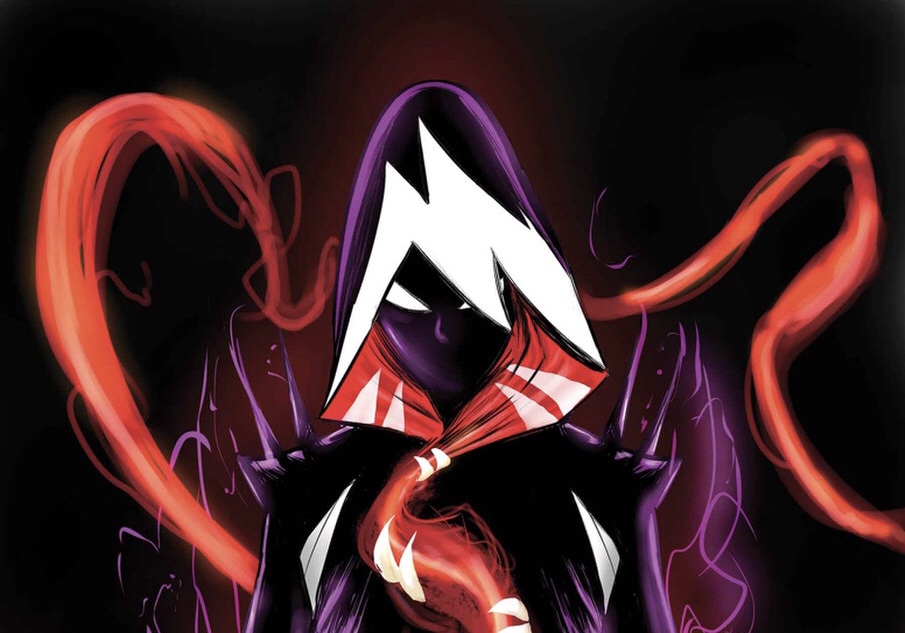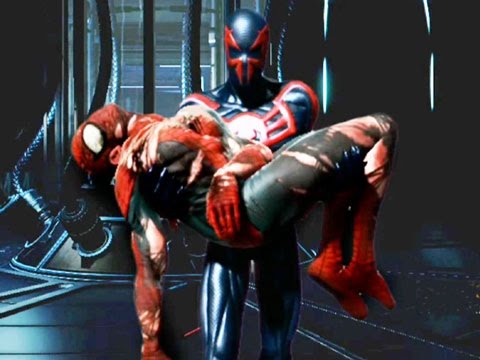This time out we take a look at Brock’s other half, the Venom symbiote itself.

Last time I outlined what I feel are the major points of criticism of Venom in his original origin story from ASM #300. Here I’m going to take a look at the first three of those which revolve around the symbiote’s nature and role within the story.
- The extraterrestrial origins of the symbiote are ill fitting for Spider-Man’s more grounded world
Essentially Spider-Man is supposed to (relatively speaking) be an ‘Average Joe’ super hero. His villains and stories work best when they revolve around grounded, street level characters and
elements that exist in the real world or are close enough to reality that they are believable if you suspend your belief a little bit. But the alien symbiote that equals one half of Venom is an extraterrestrial creature (identified since 2015 as a member of the ‘Klyntar’ race) and as such is pretty far removed from what typically pertains to Spider-Man and his world.
Fans have thus (not entirely unreasonably) felt the symbiote is out of place within Spider-Man’s narrative.
My first defence of this would be to point out how Spider-Man stories before ASM #300 had him deal with other figures and concepts beyond his usually grounded status quo. Sure, a lot of those were the results of crossovers or guest appearances, but even exempting those you had wacky stuff like Carrion and Morbius effectively being a zombie and a vampire respectively, albeit ones stemming from scientific (rather than supernatural) origins. However during the iconic Stan Lee and John Romita Senior run on the title a notable arc dealt with an ancient stone tablet that possessed some degree of magical powers. And of course as far back as Amazing Spider-Man #2, Lee and co-creator Steve Ditko had Spider-Man battle alien invaders. Whilst they were later retroactively established to not be aliens at all, for over a decade after the story’s original publication it was held as canon that Spider-Man in his third ever comic book appearance saved the Earth by averting an extraterrestrial takeover.
Essentially every so often the odd exception to prove the rule is acceptable within Spider-Man’s narrative, so Venom should not be rejected outright merely due to his alien nature.
More pressingly though Venom (and by extension Carnage) should be given a free pass on this count because honestly, their alien origins are pretty irrelevant to their characters in most stories.
Mostly (especially early on) the symbiote simply exists to grant power to Brock or its other hosts, seeks to bond with Peter again or to twist and control its other hosts.
If the symbiote had been a lab experiment (as was the case in the alternate universe Ultimate Spider-Man series) its actions, motivations and role within the narrative wouldn’t have been drastically different. It was hardly shooting ray guns, flying around in spaceships and saying ‘take me to your leader’, or anything more overtly alien/sci-fi of that nature. At the end of the day in its role as Venom it was (mostly) used as vehicle to power up people like Brock and operate as an incredibly dangerous tool in their all too down to Earth and human desires.
Even the symbiote’s own motivations boil down to an inherently human emotion, hatred of someone who rejected it. As such the symbiote can be seen as something of a metaphor for a ‘lover scorned’, someone who is part of a toxic relationship or in some stories as a drug or corrupting force (the latter mostly originating after the 1990s Spider-Man cartoon). All of which are common, arguably even universal human concepts. Think of it the same way that Spider-Man’s powers and struggles as a hero are partially metaphorical for the struggles we all face in our lives and the ‘power’ we all can and do exercise to deal with those struggles whether it’s on a small or large scale.
At most in any given story involving Venom the symbiote’s alien status is relevant only because it grants such immense power, which becomes more believable if it was not of this Earth han if it was just something a scientist whipped up in a lab. Additionally the symbiote’s anger and frustrations could be said to be heightened by virtue of it being taken to a strange place, far from its home not entirely of its own freewill; again allegorical and even relatable to something that could believably happen in the real world.
Because of this I really do think Venom and Carnage should be given a free pass for not fitting into Peter’s world exactly. Especially if characters like Carrion (a telepathic zombie clone who can kill via touch) are on the Spider-Man villain approval list.
- The symbiote’s hatred of Spider-Man is contradictory to how it had been previously portrayed
In Web of Spider-Man #1 the symbiote was desperate to bond with Peter again and even saved his life. But in ASM #300 it hates him and wishes to end his life.
Whilst definitely a 180 this is actually not all that big of a contradiction and the solution is rather interesting.
To begin with, the symbiote is a creature entirely different to a human being. It requires a host, it feeds off of adrenaline, it has a flowing liquid-like body and according to Web of Spider-Man #1, it wouldn’t normally feel emotions.
In Web #1 the narration boxes tell us that the symbiote, through its bonding with Peter, has in fact learned to feel emotions for the first time and it is this recent learning experience that informs its decision to save Peter. In other words the symbiote prior to bonding with Peter and learning emotions from him would not have risked itself to save its host.

Since it is far from a human being it isn’t really unreasonable to argue that it’s actions need not strictly speaking add up to normal human behavioural patterns. The way it thinks and feels could/clearly is very different to a human beings and as such it has a certain in-universe licence to act in an inconsistent way.
But more pressingly it’s a creature of undetermined age who has very recently (at the time of ASM #300) experienced the kaleidoscope that is the human emotional spectrum and now carries those emotions around itself. Such an experience is likely to drive the creature somewhat loopy. Alternatively they could cause it to act inconsistently as it feels new emotions that it doesn’t know how to properly process and is (by extension) probably a slave to. Its inhuman nature might even mean the way it processes and reacts to those same human emotions is not necessarily going to be the same as a human being.
However even if we presumed the symbiote to be a human being it’s emotions would again not be entirely unbelievable. In ASM #317 Peter seeks advice about the symbiote from a psychologist.


Putting the psychologist’s advice into action, Spider-Man is able lure the symbiote away from Brock and so defeat Venom once again.

As the issue conveyed the symbiote still ‘loved’ Peter, but it’s rejection by him created a deep hatred for its former host, despite it still deep down loving him. This especially makes sense if you imagine that following Web #1 the injured symbiote would likely have ruminated upon its predicament as it gradually recovered.
It would have been in a lot of pain, it had nearly died and it was in that state because it tried to help the person who rejected it after all it had done to (from its point of view) help him. In fact the symbiote had saved its host life from the very bells its host had tried to use to kill it. The symbiote was also stuck in that same church, the location of its rejection and injury and thus potentially a frequent reminder of how it got into this painful and humiliating situation. Left to strew and ruminate under such circumstances it isn’t entirely unbelievable that a human being would come to reconsider their actions and grow to hate the person they had previously tried to save. This is to say nothing of how, in bonding with Brock, his hatred for Spider-Man likely exacerbated its own (and vice versa, but more than that in future instalments).
Bear in mind again that the symbiote is new to the power of human emotions and isn’t human itself. In most respects it is more like an intelligent animal or even a child. As such its emotions could shift fairly quickly and drive it down extreme paths of action. ASM #317 even proved it to be, if not fickle, then very reactive and situational, since it tried rebonding with Peter (despite not being able to) soon after he showed signs of renewed interest in it.
- The symbiote is alive despite us seeing it die in Web of Spider-Man #1
This one is actually addressed in ASM #300 itself.
In the story Spider-Man states that the symbiote, rather than dying actually ‘dissipated’ out of pain and/or rejection.

This explanation is acceptable due to the alien’s inhuman biology, which makes its survival more acceptable than if say Doc Ock’s arms found a new owner despite us seeing them destroyed.
Much like it’s mentality, if the symbiote isn’t human and doesn’t have anything resembling a human biology (like a Skrull or a Kree kind of do) then it wouldn’t be unreasonable to accept that it could somehow reform and healed itself following Web #1’s ending.
Whilst I said I wasn’t counting it in this essay series, it should be noted for the record that this explanation (along with my explanation for the second point) was present in Deadpool: Back in Black #1.

Now we’ve dealt with the symbiote its time to move onto real meat of this essay series, Eddie Brock!
P.S. Another far smaller point of criticism bandied about regarding the symbiote is that it was too ‘ill defined’ as an alien species to fit into Spider-Man’s world, rendering it akin to a magical element in the series. To be incredibly blunt, I don’t really follow the logic of that point, however in the interests of completeness I wanted to nevertheless quickly address it.
The symbiote in ASM #258 was explained to be an alien life form which bonded to a host and over time we got more of an explanation about how it was sentient and saw from stories (such as Web of Spider-Man #1) how it learned and reacted to the emotions of its host.
Effectively it is a sentient and quasi-intelligent (and frequently learning) animal. In fact Tom DeFalco (one of the two creators to originally introduce the symbiote) once specifically compared it to a pet that loved its master and got angry over it’s rejection.
I fail to see how that is particularly ill-defined or ‘magical’.









